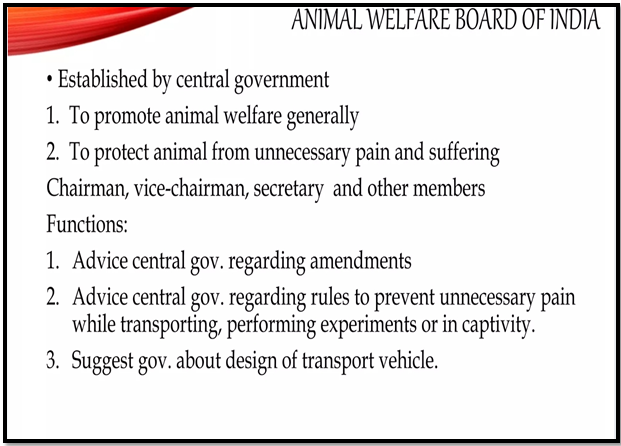STRENGTHENING ANIMAL PROTECTION LAWS
Syllabus:
GS 2:
- Government Policies and Interventions
- Important Legislation.
GS 3 :
- Economy of Animal Rearing
Focus:
The killing of Jai, a community dog in Mumbai, has sparked public outcry, highlighting the need for stronger animal protection measures in India.
Social media campaigns, such as #JusticeForJai, have mobilized public support and brought attention to the urgency of addressing animal cruelty.
Source: Slideshare
Punishment Theories:
- PCA Act inadequacies: Despite being the primary legislation on animal cruelty, the Prevention of Cruelty to Animals (PCA) Act of 1960 faces criticism for poor enforcement and lenient penalties.
- Analysis through punishment theories: The Act’s failings in achieving retribution, deterrence, and reformation goals underscore its ineffectiveness.
- Retribution: Punishment under the PCA Act often fails to provide adequate justice for the suffering inflicted upon animals, leading to calls for stricter penalties.
- Deterrence: Weak fines and bailable offences do little to deter potential offenders from committing acts of cruelty, perpetuating a culture of impunity.
- Reformation: The absence of rehabilitation measures in the PCA Act neglects opportunities for offenders to reform their behaviour and contribute positively to society.
Draft PCA (Amendment) Bill, 2022:
- Proposed amendments: The Draft Bill, introduced in November 2022, aims to address shortcomings in the existing PCA Act by enhancing penalties and adding new offences.
- Key provisions: The Bill seeks to increase fines, introduce stricter punishments, and address gaps in the current legislation.
- Critique of Draft Bill: While the proposed amendments represent progress, concerns remain regarding the adequacy of penalties and the inclusion of rehabilitation measures.
- Public consultation: The Draft Bill underwent a period of public feedback, allowing stakeholders to contribute their perspectives and recommendations for improvement.
- Legislative process: Despite delays in tabling the Draft Bill in Parliament, advocates continue to push for its swift enactment to provide better protection for animals.
Words to Heed:
- Significance of enactment: Despite limitations, passing the Draft Bill would mark a significant step forward in animal protection legislation in India.
- Advocacy for action: Calls for government prioritization of animal welfare and the passage of amendments to the PCA Act underscore the urgency for legislative reform.
- Leadership example: Rukmini Devi Arundale’s advocacy highlights India’s responsibility to lead by example in animal protection, urging swift legislative action.
- Civil society engagement: Grassroots movements, petitions, and advocacy campaigns play a crucial role in raising awareness and mobilizing public support for animal rights.
- Media coverage: Media outlets have a responsibility to report on cases of animal cruelty and amplify the voices of activists and organizations working to combat abuse.
| Other Initiatives for Protection of Animals:
1. Rashtriya Gokul Mission (RGM):
2. E-Pashu Haat Portal:
3. National Animal Disease Control Programme:
4. Animal Rescue and Rehabilitation Centers:
5. National Livestock Mission:
6. Livestock Health & Disease Control Scheme: Provides assistance for the prevention and control of animal diseases like Foot and Mouth Disease (FMD). Supports measures to enhance livestock health and prevent disease outbreaks. 7. Disease Protection of Livestock:
|
Challenges:
- Stakeholder resistance: Opposition from vested interests and lack of political will may hinder the passage of the Draft PCA (Amendment) Bill in Parliament.
- Enforcement challenges: Inadequate resources and infrastructure for enforcement pose obstacles to effective implementation of animal protection laws.
- Legal loopholes: Ambiguities in existing legislation and loopholes in enforcement mechanisms create opportunities for offenders to evade accountability.
- Cultural attitudes: Deep-rooted cultural beliefs and practices may perpetuate cruelty towards animals, necessitating educational efforts to foster empathy and compassion.
- Coordination gaps: Lack of coordination between government agencies, law enforcement, and animal welfare organizations hampers efforts to address animal cruelty comprehensively.
Way Forward:
- Stakeholder engagement: Collaborate with animal welfare organizations and legal experts to draft comprehensive legislation that addresses gaps in the existing PCA Act.
- Strengthen enforcement: Enhance penalties for serious offences, improve enforcement mechanisms, and establish dedicated task forces to combat animal cruelty.
- Public education: Launch awareness campaigns to educate citizens about animal rights, encourage reporting of cruelty, and foster a culture of compassion towards animals.
- International collaboration: Learn from best practices in other countries, collaborate with international organizations, and adopt global standards to improve India’s animal protection laws.
- Government action: Prioritize animal welfare legislation, allocate adequate resources for enforcement, and demonstrate political commitment to safeguarding animal rights.
- Judicial activism: Courts can play a crucial role in interpreting and enforcing animal protection laws, ensuring accountability for offenders and justice for animal victims.
Conclusion:
Enhancing animal protection laws is essential to ensure the welfare and rights of animals and promote a compassionate society. The government must heed public calls for stricter penalties for animal cruelty and expedite the passage of the Draft PCA (Amendment) Bill to deliver justice for victims of abuse. Protecting animals from cruelty requires collaboration between government, civil society, and the public to enact meaningful change and create a safer, more humane society.
Source:The Hindu
Mains Practice Question:
Analyzing the article on animal protection legislation, discuss the challenges faced in enforcing existing laws and propose strategies for enhancing the effectiveness of animal welfare measures in India.
Associated Article:
https://universalinstitutions.com/saving-animals-is-ethical-its-evocative-and-its-smart-business/




